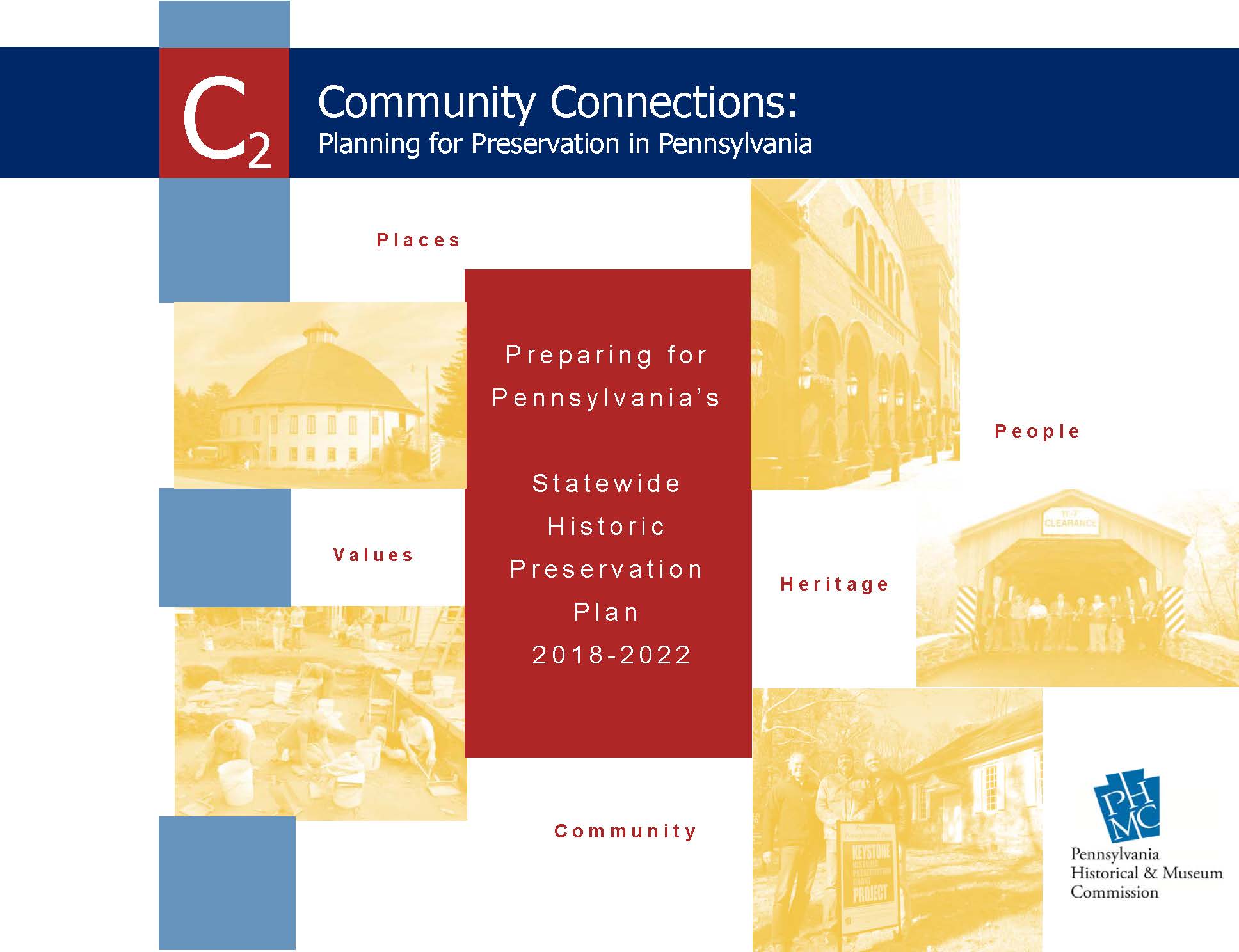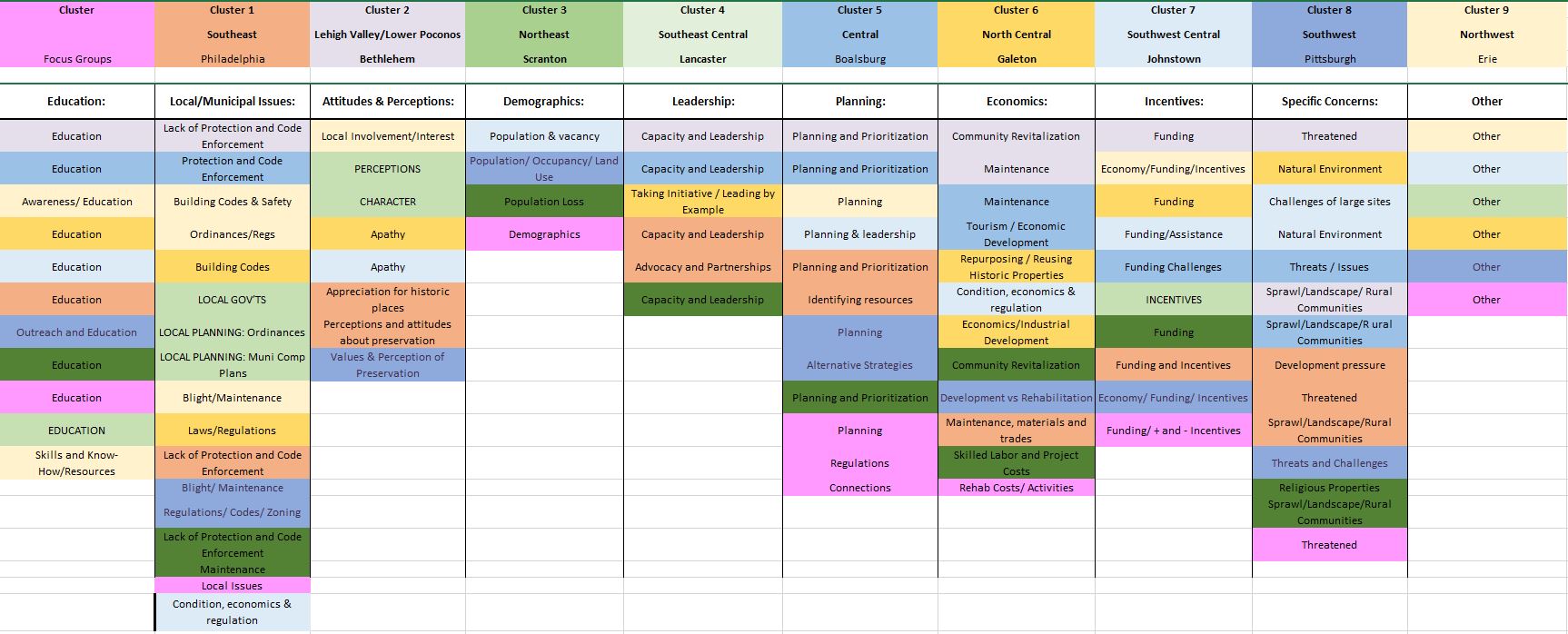I was looking back through our posts from the last few months and thought “Yikes! Its been six months since my last update on the statewide preservation plan!” So read on for the latest installment of Community Connections: Planning for Preservation in Pennsylvania.
My last check-in with our readers covered the results of the public survey we conducted last year. Check out this post if you never got a chance to look at these results or need a refresher. The results of the unscientific, yet very informative, online and paper survey provided the statewide planning team here at the SHPO with a solid foundation of public thought and opinion about their communities, historic preservation, and challenges and opportunities for the future.

Connecting with Communities for the Next Statewide Plan
So what have we been up to over the last several months? In a word – lots.
Data, data, and more data…
PA SHPO’s internal statewide plan analysis group has been working very hard to make sense of the all the data and information we have collected to date to inform the statewide plan. This includes the public survey results, over a thousand comments from survey and small focus groups (no lie!), staff input, and demographic data from the last federal census. Here is a quick snapshot:
Regional clusters: We divided Pennsylvania into 9 “cluster” regions to manage the amount of information generated by the public outreach and census. The regions were drawn to capture the known similarities in culture, history, historic resources, and issues in a group of counties. Each cluster also corresponds to one Open House location. These aren’t official regions of any type, and were only developed as a way to process and work with all the data we had.
- Cluster 1: Southeast region, Philadelphia Open House
- Cluster 2: Lehigh Valley/Lower Poconos region, Bethlehem Open House
- Cluster 3: Northeast region, Scranton Open House
- Cluster 4: Southeast Central region, Lancaster Open House
- Cluster 5: Central region, Boalsburg Open House
- Cluster 6: North central region, Galeton Open House
- Cluster 7: Southwest Central region, Johnstown Open House
- Cluster 8: Southwest region, Pittsburgh Open House
- Cluster 9: Northwest region, Erie Open House

An example of “cluster” regions used for managing and analyzing data.
Census data: Using data from the last completed census and census projections, we created regional demographic profiles for each of the clusters above that examine data points for municipalities, current population, population trends, race and ethnicity, age, poverty, and homeownership. Key findings and conclusions interpret the data and a statement about the potential implications this data has for historical and cultural resources.
Themes: The group collated the feedback from each Open House, focus group, and survey responses from the corresponding counties in each cluster region to develop the list of prominent themes. An example of a theme spreadsheet and summary is attached. We identified the following as the most prevalent themes from the Open Houses and the survey:
- Education
- Local/municipal issues
- Attitudes & Perceptions
- Demographics
- Leadership
- Planning
- Economics
- Incentives
- Specific Resource Concerns
- Other

I know its hard to read but I wanted to show you an example of just one of the many charts we used to understand the major themes that emerged from public outreach.
A Helping Hand…
In May, we hired Gannet Flemming to assist us with Planning Partner outreach and developing the statewide plan. We had a successful kick-off meeting in June with two of the company’s planners and they are off to a running start.
They will take all of the information we’ve collected and analyzed to date and use it (see above), along with current studies, articles, demographic data, etc., to identify a set of issue statements that reflect the current state of historic preservation, historic communities, above-ground and below-ground historic resources, and more in Pennsylvania. They’ll also work closely with the Planning Partners and Statewide Plan Task Force to review issues, solicit feedback, develop the Action Agenda, and help us build a strong foundation of relationships to implement the plan once it’s completed next spring.
What’s this going to look like?
Our May 2018 plan release is coming quickly! Another PA SHPO internal working group has started thinking about how we’re going to share all of this great information and the Action Agenda as “the statewide plan”.
At the start of this whole process, the PA SHPO plan steering committee and the Task Force of external advisors challenged ourselves to find a better way to share this important document. We are interested in packaging the next statewide plan in a way that is creative, practical, usable, and economical. Like some planning documents, statewide plans have traditionally been bound as a large, single document containing background information, data, goals and directives, methodology, etc. These plans also spend a great deal of time on the shelf and not used to their fullest. We want to try to change this.
The published plan will include all the important bits and pieces that should be included in a planning document like this one and the parts that the National Park Service requires us to have. But no one wants to cart around some heavy 8 1/2x 11 book to meetings or have that lying around on their desk for easy reference. The PA SHPO group working on this task are hard at work finding great images for the plan, developing the pertinent sections, etc. The planners from Gannet Flemming and this PA SHPO group are trying to think of new way to present the plan’s Action Agenda so it’s something you do want to carry around and use so often that you’ll need new copy before the next one comes around.
Have you seen any plans that you thought were creative and useful? An unorthodox way of publishing or presenting the information? If so, I’d love to hear about it – please email me!
Next steps…
Most of the work for the next few months will focus on outreach with the Planning Partners and a PA SHPO steering committee/task force meeting in late October. Our goal is to have draft documents ready for public comment and National Park Service review in the beginning of 2018.
Stay tuned for more updates!

Looking forward to the Action Plan this coming spring. We have been working on saving a very important historic building in Pittsburgh for 8 years and nothing is happening since (1) our hands were tied (2) we don’t know what we are doing but it doesn’t stop us from trying and (3) and the most important, we don’t have any money and don’t know how to raise any.